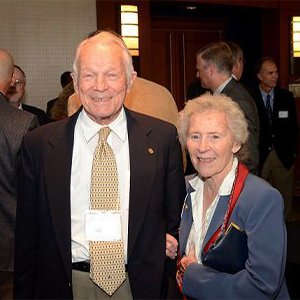 |
| Robin Gray and Fran Gray |
Beloved colleague, mentor, friend, and former Daniel Guggenheim School professor and chair Robin Gray passed away on April 6, 2022, at the age of 96. He joined the School as a master’s student in 1947 and returned in 1956, serving as Regents Professor and associate director of the School.
“Professor Gray was not only an exceptional scholar, teacher, and mentor but was also an incredible human being,” said William R. T. Oakes Professor & School Chair Mark Costello. “He was a giant in his field and at the same time - humble and kind.”
He earned his bachelor’s degree in aeronautical engineering from Rensselaer Polytechnic Institute in 1946 and his master’s degree in aeronautical engineering from Georgia Tech in 1947. While at Tech, he was a research engineer and worked with Professor Walter Castles, Jr. which began his career in rotorcraft technology. This led Gray to pursue his doctoral studies at Princeton University where he became graduate research assistant and a student of Professor Alexander Nikolsky, who was part of the team that developed the world’s first practical helicopter, the VS-300. While at Princeton, he performed the first in‐depth flow visualization study of the vortex wake of a rotor in hovering and forward flight and developed a method for applying the results to the calculation of blade loading. He earned his Ph.D. degree in 1957.
In 1956 he returned to Georgia Tech and served as the Regents Professor and associate director of the School of Aerospace Engineering. He was the acting director of the School from 1986 to 1988 and was principal investigator and technical director of Georgia Tech's U.S. Army Center of Rotary Wing Aircraft Technology from 1982 to 1986.
At Georgia Tech, Gray taught an introductory helicopter course regularly 1962-1996, and developed and taught two graduate courses on rotor aerodynamics and an introductory course on helicopter stability and control. Almost 1,200 students elected to enroll in these courses, many later became military officers, business executives, engineers, professors and astronauts.
Gray's prolific research activities included rotor model and test facility development; model rotor testing in wind tunnels, drop towers, moving test beds, and static thrust cells which dealt with performance and stability characteristics, flow visualization, wake velocity measurements, blade pressure measurements, and transition in ground effect; analysis of tip‐jet‐powered, jet‐flapped rotors; analysis, design, and testing of ducted fans; analysis of heavily loaded, optimum ducted fans; analysis and design of inflatable rotorchutes; experiments on and computer modeling of vortex rings; tip vortex core modeling; and vortex panel methods for predicting pressure distributions on thick wings and rotor blades.
Gray was awarded the Alexander A. Nikolsky Honorary Lectureship in 1991 at the American Helicopter Society’s Forum 47 Awards ceremony where he delivered his lecture titled, "Vortex Modeling for Rotor Aerodynamics”.
Since his retirement from the School in 1996, Dr. Gray and his wife Fran continued to attend and support School functions and initiatives, especially those associated with the rotorcraft legacy he helped establish. The Gray family are also avid supporters of the Georgia Tech Yellow Jackets and would regularly attend football games over the years.
Professor Gray will be greatly missed by all those who knew him. Our thoughts are with his wife Fran and their extended family and friends during this difficult time.